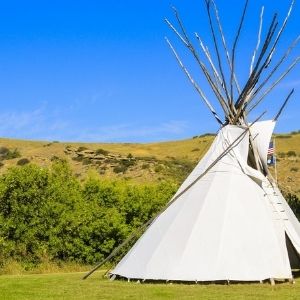Pictograph Cave State Park
Pictograph Cave State Park

Pictograph Cave State Park lies just outside of Billings, MT. This park features three caves that are preserved and protected in the 23-acre state park.
Along the rimrocks, you'll find where Pictograph Cave has drawn human beings for over 3,000 years and was home to generations of prehistoric hunters.
We are able to bring you valuable information about this amazing state park thanks to the support of:

Looking to camp?
With its abundant wildlife and vegetation, the fertile Yellowstone River valley just north of the park provided an ideal campsite for travelers. Inside the three caves at the park, you can find over 2,100-year-old pictographs from some of Montana's first inhabitants.
When and how these inhabitants arrived is still a mystery and the pictographs they left behind are still subject to great debate.
- Transport yourself back in time by exploring the caves
- Check out the Visitor Center and learn more about the history of the caves.
- Eat your picnic while gazing out at incredible views.
- Don’t forget to pick up a memento from the gift shop!
- See if you can spot any wildlife near the caves.
Due to its archeological significance, Pictograph Cave State Park was designated as a National Historic Landmark in 1964. Thousands of years ago, prehistoric hunters who camped in the Pictograph Cave left behind artifacts and over 100 pictographs. The oldest art found at Pictograph Cave State Park is over 2,000 years old and from some of the very first humans on the plains.
The three main caves in the park - Pictograph, Middle, and Ghost - were created from the Eagle sandstone cliff by water and wind erosion. The deepest of the caves, Pictograph Cave, is 160 feet wide and 45 feet deep. In 1936 the first artifacts and paintings were discovered in the caves. Roughly 30,000 artifacts were excavated from the site including, stone tools, weapons, paintings, and instruments. These artifacts helped researchers understand which native people used the caves and when.
In addition to tools and animal bones, the excavations also turned up jewelry, pendants, bracelets, and beads crafted of seashells acquired from Pacific Coast Indians, and in one excavation, researchers discovered barbed harpoon points of the Eskimo culture, made of caribou horn.
At the Park today, you'll see pictographs depicting animals, warriors, and even rifles! The different colors used in the pictographs allowed researchers to identify when people inhabited the region and gave an inside look into their lifestyle. If you’re planning to visit, be sure to bring your binoculars to get the best view of the rock art and be sure to check out the Visitor’s Center which includes interpretive displays and a gift shop.
Depending on the season you can see mountain lions, black bears, turkeys, coyotes, porcupines, red-tailed hawks, golden eagles, bald eagles, northern harriers, bobcats, mountain cottontails, rock doves, turkey vultures, mule deer, canyon wrens, magpies, ravens, crows, and chickadees.
The best time to see the pictographs is after rain or snowmelt! The moisture causes the drawings to become more prominent. And you'll give yourself about an hour to walk the trail with extra time for a picnic and bird watching.

Curious what other visitors have had to say about the park?

Park
Summer Hours
Third Friday in May-Third Sunday in September
Open Daily
Park: 9 am - 7 pmWinter Hours
Third Monday in September - Third Thursday in May
Open Wednesday - Sunday
Park: 9 am - 5 pm
Closed Monday & Tuesday, and Thanksgiving, Dec. 24, 25, 31 & Jan. 1Visitor Center
Summer Hours
Open Daily
Visitor Center: 10 am - 5 pmWinter Hours
Open Wednesday - Sunday
Visitor Center: 10 am - 4 pm
Closed Monday & Tuesday, and Thanksgiving, Dec. 24, 25, 31 & Jan. 1Location
3401 Coburn Road Billings, MT 59101
Pictograph Cave State Park Read More »


































































































